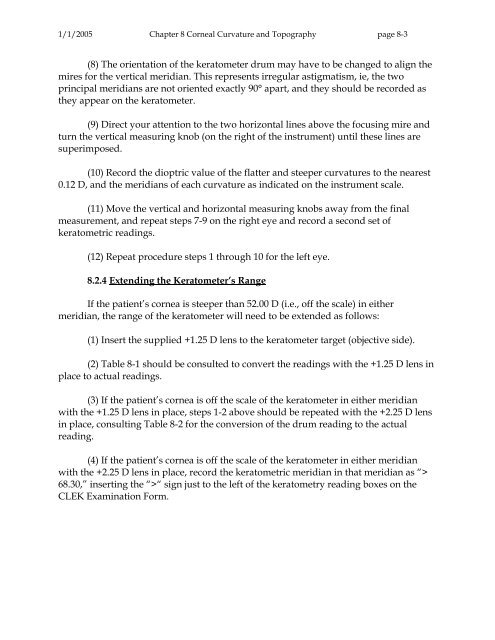OM t of c.iii - Vision Research Coordinating Center - Washington ...
OM t of c.iii - Vision Research Coordinating Center - Washington ...
OM t of c.iii - Vision Research Coordinating Center - Washington ...
Create successful ePaper yourself
Turn your PDF publications into a flip-book with our unique Google optimized e-Paper software.
1/1/2005 Chapter 8 Corneal Curvature and Topography page 8-3<br />
(8) The orientation <strong>of</strong> the keratometer drum may have to be changed to align the<br />
mires for the vertical meridian. This represents irregular astigmatism, ie, the two<br />
principal meridians are not oriented exactly 90° apart, and they should be recorded as<br />
they appear on the keratometer.<br />
(9) Direct your attention to the two horizontal lines above the focusing mire and<br />
turn the vertical measuring knob (on the right <strong>of</strong> the instrument) until these lines are<br />
superimposed.<br />
(10) Record the dioptric value <strong>of</strong> the flatter and steeper curvatures to the nearest<br />
0.12 D, and the meridians <strong>of</strong> each curvature as indicated on the instrument scale.<br />
(11) Move the vertical and horizontal measuring knobs away from the final<br />
measurement, and repeat steps 7-9 on the right eye and record a second set <strong>of</strong><br />
keratometric readings.<br />
(12) Repeat procedure steps 1 through 10 for the left eye.<br />
8.2.4 Extending the Keratometer’s Range<br />
If the patient’s cornea is steeper than 52.00 D (i.e., <strong>of</strong>f the scale) in either<br />
meridian, the range <strong>of</strong> the keratometer will need to be extended as follows:<br />
(1) Insert the supplied +1.25 D lens to the keratometer target (objective side).<br />
(2) Table 8-1 should be consulted to convert the readings with the +1.25 D lens in<br />
place to actual readings.<br />
(3) If the patient’s cornea is <strong>of</strong>f the scale <strong>of</strong> the keratometer in either meridian<br />
with the +1.25 D lens in place, steps 1-2 above should be repeated with the +2.25 D lens<br />
in place, consulting Table 8-2 for the conversion <strong>of</strong> the drum reading to the actual<br />
reading.<br />
(4) If the patient’s cornea is <strong>of</strong>f the scale <strong>of</strong> the keratometer in either meridian<br />
with the +2.25 D lens in place, record the keratometric meridian in that meridian as “><br />
68.30,” inserting the “>“ sign just to the left <strong>of</strong> the keratometry reading boxes on the<br />
CLEK Examination Form.
















